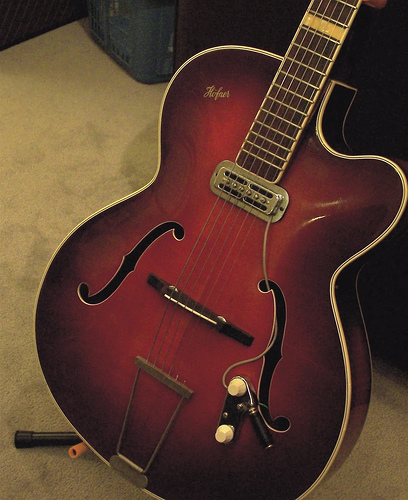Although the traditional jazz-style guitar wouldn’t be born until the 1930s, the first take on a jazz guitar was actually in 1923. This was the Gibson L5, which popular jazz musicians of the time, including Eddie Lang, would use. When the electric guitar was invented in the 1931, it would quickly become the jazz instrument of choice for those playing strings. Until this time, the banjo was the dominant instrument for jazz musicians.

What are the Differences?
Most jazz musicians will use an archtop guitar, which is a Gibson model and colloquially referred to as a jazz guitar. However, many will also use a standard electric guitar, or an electric acoustic, and use a range of gear and equipment to create the jazz sound they’re looking for.
Guitars Within Jazz
Jazz was most popular during the late 1930s and throughout the 1940s. During this time, guitars such as the Gibson ES-150, invented in 1936, would often be played by individual jazz guitarists as well as making up an important part of the rhythm section of popular jazz bands of the era.
Eddie Durham and Charlie Christian are the two musicians most widely credited with being the fathers of jazz guitar. Durham for creating the first jazz guitar solo and Christian for making jazz guitar solos a hugely popular sub-genre of music.
Moving Forward
Throughout the 1950s Gibson would continue to produce archtop guitars, including the L5CES, which was instantly popular with jazz musicians as it could be played as an acoustic or electric instrument. Tal Farlow and Johnny Smith were among the artists who would use this instrument and enjoy great popularity. However, it was Wes Montgomery and Joe Pass who would set the benchmark for what we’d describe as jazz guitar playing in the modern day.
The 1950s would also be the last time there would be any significant changes to the design of the archtop guitar, and as jazz fused with rock and moved into the mainstream through the late 1960s and 1970s, demand for these instruments would sharply fall.
Jazz Revival
The 1980s would see a move back to what many would call traditional jazz, and while the genre of music would regain popularity, it wouldn’t be until the 1990s that sales of the archtop guitar would pick up once again.
Today, the archtop guitar is available from a number of manufacturers – most sell at least one as part of their range – but the Gibson models are still the most in demand and sought after both by professional and amateur musicians.
Image Author: kurisurokku
Are you a guitarist? Check out our full range of online guitar lessonsAre you a saxophonist? Check out our full range of online saxophone lessons
Subscribe to Pro Music Tutor from as little as £7.99 per month
Related Posts
-
Is Music Theory Important to Modern Musicians?
The importance of music theory is a hot debate topic in the world of professional music. Some believe knowledge of music theory is what makes you a true musician, whereas some feel their lack of music theory knowledge is like a badge of honour. With the eternal debate over the importance of music theory raging […]
View All >> -
5 Ways Spanish Music Influenced the World
Contemporary popular music has transcended all national boundaries, with different types of music being performed and listened to in all corners of the world. Each culture also adds their own little tweaks and twists to the music, constantly creating new sounds and influences. Spanish music has deeply influenced the popular music we listen to today. […]
View All >>
Latest Blog Entries
-
The Benefits of Online Music Education
Learning music has never been easier, since the internet and modern technological advancements have opened the doors to countless possibilities, expanding the subjects people can choose from and how the lessons are taught. Now, people can study a whole host of music-related topics; from learning to play guitar or DJing, to understanding the inner workings […]
View All >> -
Essential Jazz Guitar Scales that are Easy to Learn
Improvising in jazz requires the ability to play in different keys over different chords. Results certainly do not come overnight, but with diligent practice, you would be surprised by what you can achieve. Many people ask me about what scales I use as if they were some big secret. While knowing your scales is very […]
View All >>
Blog Categories
- Categories
- Guitar Tips (93)
- History (36)
- How-To (38)
- Interviews (3)
- Music Industry (121)
- Prolinks Guitar (2)
- Prolinks Lessons (3)
- Prolinks Tutor's Profile (1)
- Saxophone Tips (40)
- Uncategorized (6)
Tags
Archive
- November 2018 (1)
- February 2018 (1)
- December 2017 (1)
- November 2017 (1)
- October 2017 (1)
- July 2017 (4)
- May 2017 (2)
- April 2017 (1)
- August 2016 (2)
- July 2016 (1)
- June 2016 (2)
- May 2016 (3)

